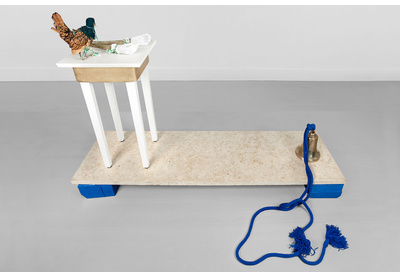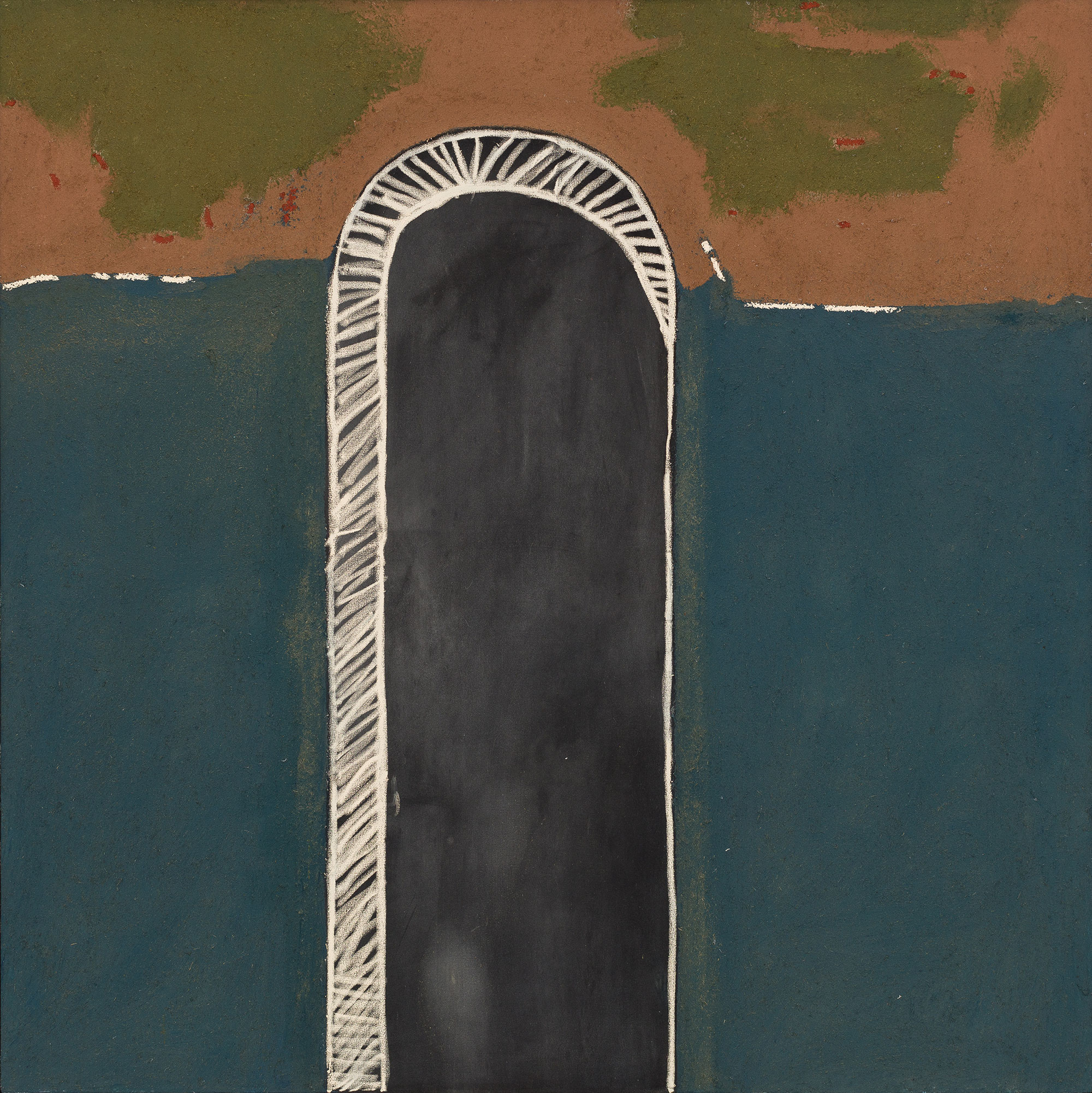I want you to talk about your main and artistic modality, and what you see to be the symbolic and literal place you as an artist occupy, in both the western context and in your African context.
Themba Tsotsi in conversation with Mawande Ka Zenzile from South Africa
South African artist Mawande Ka Zenzile has a seventh solo exhibition currently running at the Stevenson gallery in Johannesburg. Titled “Nqanda nanga’manzi engine ‘ndlini” (Stop the water from going into the house). The title is a Xhosa proverb about unforeseen accidents, it anchors works from Ka Zenzile’s collection that achieve combining the depth and foreground of the art works. Ka Zenzile has achieved an evolution of impact in this show. That is in this collection canvases are unified and compact in form and subject, to achieve synthesis between subject and what is represented, and what is represented and the artist. Unlike in previous works where the background and the foreground were unified by a symbolic line. In this collection works are imbued with the unified measure of a body of water.
I had the pleasure of being invited by the artist to conduct a discussion about his recent body of work. The discussion centred around the function of representation, the historic role he occupies as an artist and how he comes to choose the materials he works with. The following is the discussion, as a writer I tried to keep true to the events on the day as they happened as much as possible. The extract includes audience participation and the contribution of curator and writer Sinazo Chiya.
I just want to thank the Stevenson gallery and Mawande for this opportunity to actually talk as a writer and talk with someone who not only studied with me but influenced my thinking a lot, especially when it comes to writing about art. So, I’m just going to get into it, I’m going to ask questions that I know are on the surface with you, but they are deep with me. So, can you please explain your cultural background? Do you perceive it as a combative instrument in terms of how you want your work to be interpreted? And I am thinking about the work, “Umandlalo”, the installation that you had at Stevenson Cape Town. I want you to talk about your main and artistic modality, and what you see to be the symbolic and literal place you as an artist occupy, in both the western context and in your African context.
What a loaded question. I did not have a choice because I was born in Xhosa culture, Xhosa tradition, the locality, the centre but I exist as part of the global world. So, it’s the language that I understand, it’s my mother tongue, but art is universal. So, aesthetics are universal, it’s just that in the west they decided to name it “beauty”. But it’s something nameless, it’s like making love, you cannot really describe it. And that’s what I’m interested in, in my work, not particularly interested in just – I mean there are a lot of people who do the job of representing Xhosa people in the art world better than me, but that’s not what I’m interested in.
Just continue with that train of thought. Now, talk about your organic approach to work? How much influence does western thinking influence it? Do you feel limited by influences outside your cultural sphere?
Yeah. Again, you know, Xhosa modalities. I mean I’m also exposed to different kinds of realities. I grew up in the Eastern Cape and growing up in the Eastern Cape, there were all these sensibilities that I was exposed to and as a practising artist who has access to all these different realities, that became the centre for me to express myself. Those sensibilities are universal, they are not only central to Xhosa culture. I just wanted to share them with the world. We live in a very materialistic world that is so monolithic in a way. It cuts out everything that doesn’t belong in the dominant culture, you know. So, I’m interested in these nuances about the world we live in so that they don’t disappear. Because there’s a tension between science and the mythical reality, and I think those realities can coexist. So being exposed to European culture didn’t mean that I should assimilate. So, for me the point was to understand what it is and find a way to disenchant because we are so enchanted by it psychologically, that it kind of defines our reality. I mean, I’m educated but being educated doesn’t mean that I should assimilate, and I think for me what is much more interesting is that, one becomes able to uphold the contrasting view and that’s how I define intelligence. Not to be assimilated by the views.

Now, do you feel pressured to balance these two worlds, to balance these paradigms?
I mean, I never belonged and I don’t feel pressure to belong anywhere and so art gives me that freedom to just play around and not be enchanted. It gives me a space to just connect with myself, it helps me to define or to separate what is the collective consciousness and myself, and I feel that’s something that the broader society needs. Otherwise, there will be no suffering. So, art allows and puts me in that space beyond affectation. It’s such a holy space, you know.
(Sinazo Chiya) I want to just talk about the thing that you both have been talking about so long, it’s like the idea of the paradigm shift and the work articulating, like, as you say, these modalities. It’s not combative, its merely shifting paradigms, and combining these worlds in a way that heals, instead of making a stick.
I mean what allows one to shift paradigm is about one being freed from the psychological trappings. It’s hard for educated people, this is what I’ve come to realise because it has been so pervasive the idea of how the world should function and what it means to be intelligent, what is reality, philosophically how we understand reality. So even if we talk about decolonisation, I realise that a lot of people are still talking about this idea within the rational point of view. They haven’t transcended the paradigm of rational thinking, it’s a psychological entrapping that one needs to liberate oneself from and then it allows you to see broader.
You’re always talking about – when we’re talking about being freed by your work and especially in a psychological sense. Now, talk about how your work connects to the collective consciousness and the collective unconscious.
I mean, it’s such a privilege to make art because it’s kind of like meditative without you sitting cross legged, it stops thinking and I think thinking – because it’s a lot of suffering, especially if it consumes you, you believe but if you are able to separate yourself from the content of thoughts, it makes it easy for you to connect with your true self, and we don’t understand thinking. That’s what I’ve realised you know. I think the majority of us, we think thinking is ours. Happy thoughts invade your mind, it changes how you feel. Negative thoughts invade your mind and it changes how you feel, but something else remains and you could tell how you’re feeling later on, and I’m interested in what stays. So, the collective consciousness is just a content of a collective content, of a psychological content of things that have been said, written about; but then, are you your thoughts? That’s what I’m interested in. Can you go beyond that? Can you push it a step further?
You also always talk about what pushes you, but that also has a language and sometimes it’s not discernible. Expand that as well because I know my issue is always why you also have works with no images, and it’s such extensive titles.
Sometimes I use a title as an entry point, but I think language also can be limiting. These are emotions that we cannot describe and I’m interested in that because that’s what happens when I’m in my space, when I’m in my studio. That I liberate myself from a sort of didactical approach to art. I think we suffer a lot from that as educated people, that the art history, historicism, historicity; it kind of limits how far we can push our creativity. But I think creativity transcends all these limitations. So, for me, that’s like my own point of entry.
Can you talk about the relationship of your work to the image of the leviathan. Now, do you feel like aspects of your modality have been devoured by philosophy or history and that through measures of myth-making that the aspects of your cultural background, also in your contemporary context, have been devoured by those schools of thought?
For the leviathan is science-ism. Finding my way to liberate myself from it. A leviathan goes back to your book, but I don’t have time to theorise now, but how society has been defined and how the idea of behaviourism from western science has been developing into an institution that it is today. It’s interesting to always go back to classical theory, classical literature which is something we are not afforded with at the university. University only teaches you secondary knowledge, you know, who says what about what, very deductive approach to thinking. So, for me, I’m interested in these epistemic tensions. How do you make sense of whatever? And so, it’s the same approach also to theory, it’s the same approach also to my art as well without appealing to authority, without feeling that you have to fit in within a paradigm…I’m high.
Stay high man. It’s cool. Now you were also telling once about the quintessential image that articulates your work is the scarecrow. Now, do institutions and social institutions, how do you articulate them in your work? Like academic institutions as well, do they fit into this image of the scarecrow? Do they define this image of the scarecrow in your work?
The scarecrow is like a scholar, but not a scholar practitioner. He’s a scholar, someone who has assimilated into the paradigm, who has no voice, who does revisionism, who…

